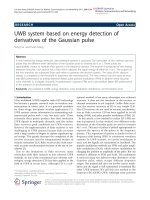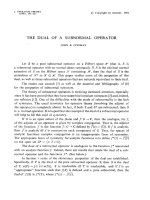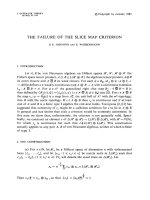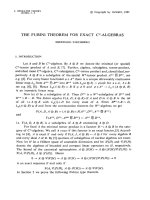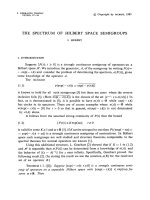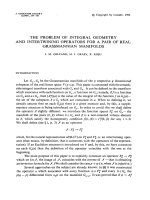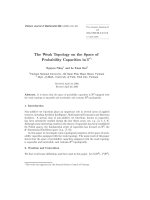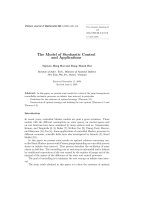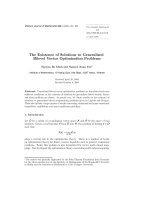Báo cáo toán học: "The Weak Topology on the Space of Probability Capacities in Rd" pot
Bạn đang xem bản rút gọn của tài liệu. Xem và tải ngay bản đầy đủ của tài liệu tại đây (133.91 KB, 11 trang )
Vietnam Journal of Mathematics 33:3 (2005) 241–251
The Weak Topology on the Space of
Probability Capacities in R
d
*
Nguyen Nhuy
1
and Le Xuan Son
2
1
Vietnam National University, 144 Xuan Thuy Road, Hanoi, Vietnam
2
Dept. of Math., University of Vinh, Vinh City, Vietnam
Received April 24, 2003
Revised April 20, 2005
Abstract. It is shown that the space of probability capacities in R
d
equipped with
the weak topology is separable and metrizable, and contains
R
d
topologically.
1. Introduction
Non-additive set functions plays an important role in several areas of applied
sciences, including Artificial Intelligence, Mathematical Economics and Bayesian
statistics. A special class of non-additive set functions, known a s capacities,
has been intensively studied during the la st thirty years, see, e.g., [3, 5 - 7, 9].
Although some interesting results in the theory of capacities has been established
for Polish spaces, the fundamental study of capacities has focused on R
d
, the
d−dimensional Euclidean space (e.g., [7, 9]).
In this paper we investigate some topological properties of the space of prob-
ability capacities equipped with the weak topology. The main result of this paper
shows that the space of probability capacities equipped with the weak topology
is separable and metrizable, and contains R
d
topologically.
2. Notation and Convention
We first recall some definitions and facts used in this paper. Let K(R
d
), F(R
d
),
∗
This work was supported by the National Science Council of Vietnam.
242 Nguyen Nhuy and Le Xuan Son
G(R
d
), B(R
d
) denote the family of all compact sets, close d sets, open sets and
Borel sets in R
d
, respectively.
By a capacity in R
d
we mean a set function T : R
d
→ R
+
=[0, +∞)
satisfying the following conditions:
(i) T (∅)=0;
(ii) T is alternating of infinite order: For any Borel sets A
i
,i=1, 2, ,n; n ≥
2, we have
T
n
i=1
A
i
≤
I∈I(n)
(−1)
#I+1
T
i∈I
A
i
, (2.1)
where I(n)={I ⊂{1, ,n},I= ∅} and #I denotes the cardinality of I;
(iii) T (A)=sup{T (C): C ∈K(R
d
),C⊂ A} for any B orel set A ∈B(R
d
);
(iv) T (C)=inf{T (G): G ∈G(R
d
),C⊂ G}, for any compact set C ∈K(R
d
).
A capacity in R
d
is, in fact, a generalization of a measure in R
d
. Clearly any
capacity is a non-decreasing set function on Borel sets of R
d
.
By support of a capacity T we mean the smallest closed set S ⊂ R
d
such that
T (R
d
\S)=0. The support of a capacity T is denoted by supp T .Wesaythat
T is a probability capacity in R
d
if T has a compact support and T(supp T )=1.
By
˜
C we denote the family of all probability capacities in R
d
.
Let T be a capacity in R
d
. Then for any measurable function f : R
d
→ R
+
and A ∈B(R
d
), the function f
A
: R → R defined by
f
A
(t)=T ({x ∈ A : f(x) ≥ t})fort ∈ R (2.2)
is a non-increasing function in t. Therefore we can define the Choquet integral
A
fdTof f with respect to T by
A
fdT=
∞
0
f
A
(t)dt =
∞
0
T ({x ∈ A : f(x) ≥ t})dt. (2.3)
If
A
fdT<∞,wesaythatf is integrable. In particular for A = R
d
we write
R
d
fdT=
fdT.
Observe that if f is bounded, then
A
fdT=
α
0
T ({x ∈ A : f(x) ≥ t}dt, (2.4)
where α =sup{f(x): x ∈ A}.
In the general case if f : R
d
→ R is a measurable function, we define
A
fdT=
A
f
+
dT −
A
f
−
dT, (2.5)
where f
+
(x)=max{f (x), 0} and f
−
(x)=max{−f(x), 0}.
The Weak Topology on the Space of Probability Capacities in R
d
243
3. The Weak Topology on the Space of Probabilitiy Capacities
Let B be a family of sets of the form
B = {U(T ; f
1
, ,f
k
;
1
, ,
k
): T ∈
˜
C,f
i
∈ C
+
0
(R
d
),
i
> 0,i=1, ,k},
(3.1)
where
U(T ; f
1
, ,f
k
;
1
, ,
k
)={S ∈
˜
C : |
f
i
dT −
f
i
dS| <
i
,i=1, ,k}
=
k
i=1
U(T ; f
i
;
i
), (3.2)
and C
+
0
(R
d
) denotes all continuous non-negative r eal valued functions with com-
pact support in R
d
. Obviously the family B is a base of a topology on
˜
C. This
topology is called the weak topology on
˜
C.
For any point x ∈ R
d
let T
x
= δ
x
be the set function defined by
δ
x
(A)=
1ifx ∈ A
0ifx/∈ A
(3.3)
for A ∈B(R
d
). Clearly that T
x
is a probability capacity in R
d
. The following
Lemma is proved in [9].
Lemma 3.1. For x ∈ R
d
we take T
x
= δ
x
with δ
x
define d by (3.3). Then for
any measurable function f : R
d
→ R
+
we have
fdT
x
= f(x) for every x ∈ R
d
. (3.4)
Let
˜
C denotes the spa ce of all probability capacities in R
d
equipped with the
weak topology. In this section we show that
Theorem 3.2.
˜
C is sep a rable and metrizable.
The Theorem will be proved by Propositions 3.3 and 3.7 below.
Proposition 3.3.
˜
C is a regular space.
Proof. Assume that A is a closed set in
˜
C, T ∈
˜
C and T/∈A. We will show that
there are neighborhoods U and V of T and A respectively, such that U∩V= ∅.
Since A is closed and T/∈A,thereexist f
i
∈ C
+
0
(R
d
), and
i
> 0,i=1, ,k
such that
U(T ; f
1
, ,f
k
;
1
, ,
k
) ∩A= ∅. (3.5)
For each i =1, ,k, we define
A
i
= {S ∈A: S/∈U(T ; f
i
;
i
)}. (3.6)
244 Nguyen Nhuy and Le Xuan Son
From (3.5) and (3.6) we get
A =
k
i=1
A
i
. (3.7)
We put
V
i
=
S∈A
i
U(S; f
i
;
i
/3). (3.8)
For any S
∈V
i
and for any T
∈U(T ; f
i
;
i
/3) from (3.6) and (3.8) we have
|
f
i
dT
−
f
i
dS
|≥|
f
i
dT −
f
i
dS|−|
f
i
dT −
f
i
dT
|
−|
f
i
dS −
f
i
dS
|
>
i
−
i
3
−
i
3
=
i
3
> 0
for some S ∈A
i
. That means
U(T ; f
i
;
i
/3) ∩V
i
= ∅ for i =1, ,k.
Hence
U(T ; f
1
, ,f
k
;
1
/3, ,
k
/3) ∩ (
k
i=1
V
i
)=∅.
Consequently, take U = U(T ; f
1
, ,f
k
;
1
/3, ,
k
/3) and V =
k
i=1
V
i
to
complete the proof of the proposition.
Let T be a probability capacity in R
d
and let f : R
d
→ R be a continuous
function with compact support and let {x
i
: i =1, ,k}⊂supp f be a finite
set in supp f for which we may assume that
0 <f(x
1
) <f(x
2
) < ···<f(x
k
).
We take x
0
∈ R
d
with f(x
0
) = 0, put A = {x
i
: i =0, 1, ,k} and define
T
A
f
=
k−1
i=1
(t
i
− t
i+1
)δ
x
i
+ t
k
δ
x
k
+(1− t
1
)δ
x
0
,
where t
i
= T ({x ∈ R
d
: f(x) >f(x
i
)})fori =1, ,k and δ
x
is defined by
(3.3).
Observe that T
A
f
∈
˜
C and
fdT
A
f
=
k−1
i=1
(t
i
− t
i+1
)f(x
i
)+t
k
f(x
k
)
=
k−1
i=0
[f(x
i+1
) − f(x
i
)]t
i+1
.
(3.9)
To prove Proposition 3.7 we need Lemmas 3.4 and 3.6 below.
The Weak Topology on the Space of Probability Capacities in R
d
245
Lemma 3.4. Let D be a countable dense set in R
d
. Then for any T ∈
˜
C,
for any f ∈ C
+
0
(R
d
) and for any >0 there exists a finite set A = {x
i
: i =
0, 1, ,k− 1}⊂D such that T
A
f
∈U(T ; f; ).
Proof. For T ∈
˜
C and f ∈ C
+
0
(R
d
)wehave
fdT=
α
0
T ({x ∈ R
d
: f(x) ≥ t})dt,
where α =sup{f (x): x ∈ R
d
} < ∞. Note that by the compactness of suppf ,
we have
α
0
=inf{f (x): x ∈ R
d
} =0.
Since f ∈ C
+
0
(R
d
)andD is dense in R
d
, D ∩ (supp f ) is dense in supp f.
Therefore, for any >0wecanchoosex
i
∈ D ∩ (supp f),i=1, ,k− 1with
α
0
=0<α
1
= f(x
1
) < ···<α
k−1
= f(x
k−1
) ≤ α
k
= α (3.10)
such that
0 ≤ α
i+1
− α
i
<for every i =0, ,k− 1. (3.11)
For every i =0, ,k let
t
i
= T ({x ∈ R
d
: f(x) >α
i
}). (3.12)
Then for t ∈ (α
i
,α
i+1
]wehave
t
i+1
≤ T ({x ∈ R
d
: f(x) ≥ t}) ≤ t
i
,i=0, ,k− 1.
Hence, by virtue of (3.11) and with noting that t
0
≤ 1andt
k
= 0 (see (3.12))
we have
0 ≤
fdT−
k−1
i=0
(α
i+1
− α
i
)t
i+1
≤
k−1
i=0
[(α
i+1
− α
i
)t
i
− (α
i+1
− α
i
)t
i+1
]
=
k−1
i=0
(α
i+1
− α
i
)(t
i
− t
i+1
)
<
k−1
i=0
(t
i
− t
i+1
) ≤ .
That means
|
fdT−
k−1
i=0
(α
i+1
− α
i
)t
i+1
| <. (3.13)
We take x
0
∈ D such that f (x
0
) = 0. Note that for A = {x
i
: i =0, ,k− 1}
from (3.9) we have
246 Nguyen Nhuy and Le Xuan Son
fdT
A
f
=
k−2
i=0
(α
i+1
− α
i
)t
i+1
. (3.14)
Thus, from (3.13) and (3.14) we get
|
fdT−
fdT
A
f
| <+(α
k
− α
k−1
)t
k
= .
Therefore T
A
f
∈U(T ; f; ). The lemma is proved.
Note that the set function T
A
f
defined in the proof of Lemma 3.4 is a proba-
bility capacity with finite support. Hence, Lemma 3.4 immediately implies the
following corollary.
Corollary 3.5. The probability capacities with finite support are weakly dense
in the space
˜
C.
Lemma 3.6. Let f,g ∈ C
+
0
(R
d
) and be a positive real such that
|f(x) − g(x)| <forallx∈ R
d
. (3.15)
Then we have
|
fdT−
gdT|≤ for every T ∈
˜
C.
Proof. Note that if f(x) ≤ g(x) for all x ∈ R
d
, then
fdT≤
gdT for e very
T ∈
˜
C. Let
β =sup{g(x):x ∈ R
d
}.
From (3.15) we have
fdT≤
(g + )dT
=
β+
0
T ({x ∈ R
d
: g(x)+ ≥ t})dt
=
0
T ({x ∈ R
d
: g(x)+ ≥ t})dt +
β+
T ({x ∈ R
d
: g(x) ≥ t − })dt
= +
β
0
T ({x ∈ R
d
: g(x) ≥ t})dt
= +
gdT for every T ∈C.
Similarly
The Weak Topology on the Space of Probability Capacities in R
d
247
gdT≤ +
fdT.
Thus, the lemma is proved.
Let C and Q denote a countable dense set of C
+
0
(R
d
)and(0, 1), respectively.
Denote
G = {
k
i=1
U(T
A
i
g
i
; g
i
; δ
i
): A
i
∈F(D),g
i
∈ C, δ
i
∈ Q, i =1, ,k},
where F(D) is the family of all finite sets of D. Using Lemmas 3.4 and 3.6 we
will show that
Proposition 3.7. G is a countable base of the weak topology in
˜
C.
Proof. Clearly G is co untable. We prove that G is a base of the weak topology
in
˜
C.
Given U(T ; f
1
, ,f
k
;
1
, ,
k
) ∈ B.SinceC is dense in C
+
0
(R
d
), for each
i =1, ,k there exists g
i
∈ C such that
|f
i
(x) − g
i
(x)| <δ
i
for all x ∈ R
d
,
where δ
i
∈ Q, δ
i
</4and =min{
i
: i =1, ,k}. By Lemma 3.6,
|
f
i
dT −
g
i
dT |≤δ
i
for every T ∈
˜
C,i=1, ,k. (3.16)
On the other hand, by Lemma 3.4 for each i =1, ,k we can choose A
i
=
{x
i
j
: j =1, ,n
i
}∈F(D) such that
|
g
i
dT −
g
i
dT
A
i
g
i
| <δ
i
. (3.17)
Therefore for every S ∈U(T
A
g
i
; g
i
; δ
i
), from (3.16) and (3.17) we have
|
f
i
dT −
f
i
dS|≤|
f
i
dT −
g
i
dT | + |
g
i
dT −
g
i
dT
A
i
g
i
|
+ |
g
i
dT
A
i
g
i
−
g
i
dS| + |
g
i
dS −
f
i
dS|
<δ
i
+ δ
i
+ δ
i
+ δ
i
=4δ
i
<
for every i =1, ,k.Thus
S ∈U(T ; f
i
;
i
) for every i =1, ,k.
Consequently
k
i=1
U(T
A
i
g
i
; g
i
; δ
i
) ⊂U(T ; f
1
, ,f
k
;
1
, ,
k
),
248 Nguyen Nhuy and Le Xuan Son
and the proposition is proved.
The proof of the theorem is finished. Thus, since
˜
C equipped with the weak
topo logy is a metric space, we can define the notion of weak convergence of a
sequence in
˜
C as follows.
Definition 3.8. A sequence of capacities {T
n
}
∞
n=1
⊂
˜
C is said to be weakly
convergent to the capacity T ∈
˜
C if and only if
fdT
n
→
fdTfor every
f ∈ C
+
0
(R
d
).
In comparison with the notion of the weak topology, we have the following
proposition.
Proposition 3.9. Theconvergenceintheweaktopologyandtheweakconver-
gence are equivalent.
Proof. Let T
n
be a sequence of probability capacities in R
d
and T ∈
˜
C. As-
sume that T
n
is weakly convergent to T. Let U(T ; f
1
, ,f
k
;
1
, ,
k
),f
i
∈
C
+
0
(R
d
),
i
> 0,i =1, ,k be a neighborhood of T in the weak top ology. For
every i =1, ,k there exists n
i
∈ N such that
|
f
i
dT
n
−
f
i
dT | <
i
for all n ≥ n
i
.
Let n
0
=max{n
i
,i=1, ,k}. Then we have
|
f
i
dT
n
−
f
i
dT | <
i
for all n ≥ n
0
and for all i =1, ,k.
Hence
T
n
∈U(T ; f
1
, ,f
k
;
1
, ,
k
) for all n ≥ n
0
.
That means T
n
→ T in the weak topology.
Conversely, let T
n
→ T in the weak top ology. For given f ∈ C
+
0
(R
d
)and>
0, let U(T ; f ; ) be a neighborhood of T in the weak topology. Then there exists
n
0
∈ N such that
fdT
n
−
fdT
<for a ll n ≥ n
0
,
i.e., T
n
converges weakly to T .
The following prop osition shows that the convergence on compact sets im-
plies the weak convergence.
Proposition 3.10. Let {T
n
}
∞
n=1
be a sequence of probability capacities in R
d
and T ∈
˜
C.IfT
n
(C) → T (C) for every C ∈K(R
d
),thenT
n
is weakly convergent
to T .
Proof. Assume that T
n
(C) → T (C) for every C ∈K(R
d
). For f ∈ C
+
0
(R
d
)we
put
α =sup{f(x): x ∈ R
d
} < ∞.
The Weak Topology on the Space of Probability Capacities in R
d
249
Since {x ∈ R
d
: f(x) ≥ t} is compact for any t>0, we have
T
n
({x ∈ R
d
: f(x) ≥ t}) → T ({x ∈ R
d
: f(x) ≥ t}) for every t ∈ [0, 1].
Since
g
n
(t)=T
n
({x ∈ R
d
: f(x) ≥ t}) ≤ 1 for every t ∈ R and n ∈ N,
by the Lebesgue’s bounded convergence Theorem [4] we get
α
0
T
n
({x ∈ R
d
: f(x) ≥ t})dt →
α
0
T ({x ∈ R
d
: f(x) ≥ t})dt.
Therefore
fdT
n
→
fdTfor ev ery f ∈ C
+
0
(R
d
).
That means T
n
is weakly convergent to T .
4. Topological Emb edding R
d
into
˜
C
Note that the corresponding x → T
x
= δ
x
,withδ
x
defined by (3.3), is one-to-
one between R
d
and the set of the probability measures {T
x
: x ∈ R
d
}⊂
˜
C.
Therefore, in some sense the class of capacities in R
d
also contains R
d
. In a such
way, let V : R
d
→
˜
C be a transform defined by
V (x)=T
x
for every x ∈ R
d
. (4.1)
We now show that
Theorem 4.1. The map V : R
d
→
˜
C is a topologic al embedding, i.e, R
d
is
homeomorphic to V (R
d
), which is the closed subset of
˜
C.
Proof. Clearly V (x) = V (y)forx = y.Moreover,ifx
n
→ x then for any
f ∈ C
+
0
(R
d
), from (3.4) we have
fdT
x
n
= f(x
n
) → f(x)=
fdT
x
.
Therefore V (x
n
) → V (x), and so V is continuous in the weak topology.
Conversely, assume that T
x
n
→ T ∈
˜
C in the weak topology. We claim that
x
n
→ x and T = T
x
for some x ∈ R
d
. In fact, T
x
n
→ T implies
fdT
x
n
=
f(x
n
) →
fdTfor every f ∈ C
+
0
(R
d
).
We will now show that there exists f ∈ C
+
0
(R
d
) such that
γ =
fdT>0.
For given >0let
G = {x ∈ R
d
: d(x, supp T ) <}.
250 Nguyen Nhuy and Le Xuan Son
Then supp T and R
d
\G are disjoint closed sets, by the Urysohn-Tietze Theorem
we can find a continuous function f : R
d
→ [0, 1] such that
f(x)=
1ifx ∈ supp T
0ifx ∈ R
d
\ G.
Note that the compactness of supp T implies the compactness of supp f, hence
f ∈ C
+
0
(R
d
). Since T (supp T )=1, we have
γ =
fdT=
1
0
T ({x : f(x) ≥ t})dt ≥
1
0
T (supp T )dt =1> 0.
Since f(x
n
) → γ>0, for 0 <δ<γthere is n
0
∈ N such that
|f(x
n
) − γ| <δfor all n ≥ n
0
.
That means
x
n
∈ supp f for all n ≥ n
0
.
By the compactness of supp f there is a subsequence {x
n
k
}⊂{x
n
} such that
x
n
k
→ x ∈ R
d
.
If x
n
x, then there exists a subsequence {x
n
k
}⊂{x
n
} such that
|x
n
k
− x|≥δ>0 for all k ∈ N. (4.2)
Again, by the compactness of supp f, there is a subsequence {x
n
k
}⊂{x
n
k
}
such that x
n
k
→ x
∈ R
d
.Thenwehave
T
x
n
k
→ T
x
and T
x
n
k
→ T
x
.
Since {T
x
n
k
}, {T
x
n
k
}⊂{T
x
n
} and T
x
n
→ T ,wegetT
x
= T
x
= T, and so
x = x
. From (4.2) we obtain a contradiction. Hence x
n
→ x.Consequently
V
−1
is continuous.
Remark 4.2. By Theorem 4.1 we can identify R
d
with the closed subset V (R
d
)
of
˜
C. Therefore, the space
˜
C contains R
d
topologically.
Acknowledgement. The authors are grateful to N. T. Nhu and N. T. Hung of New Mex-
ico State University for their helpful suggestions and comments during the preparation
of this paper.
References
1. P. Billingsley, Convergence of Probability Measures, John Wiley & Sons, New
York, Chichester. Brisbane, Toronto, 1968.
2. G. Choquet, Theory of capacities, Ann. Inst. Fourier 5 (1953-1954) 131–295.
3. S. Graf, A Radon - Nikodym theorem for capacities, J. Reine und Angewandte
Mathematik 320 (1980) 192–214.
The Weak Topology on the Space of Probability Capacities in R
d
251
4. P. R. Halmos, Measure Theory, Springer-Verlag, New York, Inc, 1974.
5. P. J. Huber and V. Strassen, Minimax test and the Neyman-Pearson lemma for
capacities, Ann. Statist. 1 (1973) 251–263.
6. N. T. Hung, Nguyen T. Nhu, and Tonghui Wang, On capacity functionals in inter-
val probabilities, Inter. J. Uncertainty, Fuzziness and Knowledge-Based Systems
5(1997) 359–377.
7. Nguyen T. Hung and B. Bouchon-Meunier, Random sets and large deviations
principle as a foundation for possibility measures, Soft Computing 8 (2003) 61–
70.
8. J. B. Kadane and L. Wasserman, Symmetric, Coherent, Choquet capacities, Ann.
Statist. 24 ( 1996) 1250–1264.
9. Nguyen Nhuy and Le Xuan Son, Probability capacities in
R
d
and Choquet inte-
gral for capacities, Acta Math. Vietnam. 29 (2004) 41–56.
10. T. Norberg, Random capacities and their distributions, Prob. Theory Relat.
Fields. 73 (1986) 281–297.
11. D. Schmeidler, Sujective probabilit y and expected utility without additivity,
Econometrica. 57 (1989) 571–587.
